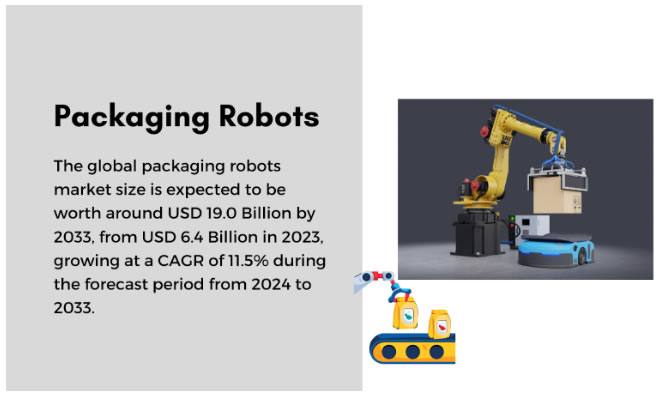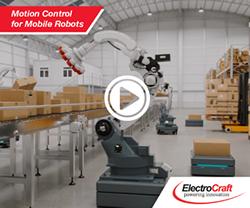Packaging Robots Industry Statistics: Market to Reach USD 19.0 Billion by 2033

Introduction
Packaging robots are becoming increasingly popular due to their ability to streamline operations and reduce labor costs. These robots are versatile and can be used for a variety of packaging tasks, such as filling, loading, palletizing, and sorting. Their adoption is further supported by advancements in robotics technology that improve their functionality and accessibility.
Based on the research findings of Market.us, The global market for packaging robots is anticipated to exhibit substantial growth over the forecast period from 2024 to 2033. The market size, valued at USD 6.4 Billion in 2023, is projected to escalate to approximately USD 19.0 Billion by 2033, achieving a Compound Annual Growth Rate (CAGR) of 11.5%. This significant growth trajectory underscores the increasing automation in packaging processes across various industries.
In 2023, the Asia-Pacific (APAC) region emerged as a prominent player in this market, securing a major share of over 35.3%, which translated into revenues of approximately USD 2.2 billion. This dominance is attributed to the rapid industrialization and expansion of manufacturing capabilities in the region, coupled with a growing emphasis on enhancing packaging efficiency through automation.
The expansion of the packaging robots market is also facilitated by the broader adoption of automation technologies in manufacturing. As industries seek more innovative ways to meet consumer demands and handle complex packaging tasks, the role of packaging robots becomes more pivotal. This trend is expected to continue, fostering further growth and development in the robotics sector.
Packaging Robots Statistics
-
The global packaging robots market is projected to witness significant growth, reaching approximately USD 19.0 billion by 2033, a sharp increase from USD 6.4 billion in 2023. This represents a compound annual growth rate (CAGR) of 11.5% during the forecast period from 2024 to 2033.
-
In 2023, the claw segment dominated the market, holding over 28.4% of the global packaging robots market share. Furthermore, the packaging segment captured more than 44.3% of the global packaging sensors market, while the food and beverage segment secured 27.4% of this market, reflecting strong momentum in these sectors.
-
Regionally, APAC led the global packaging sensors market with a 35.3% share in 2023, driven by heightened demand for packaging automation across industries.
-
In parallel, the Smart Robots Market is anticipated to expand substantially, reaching a valuation of approximately USD 128.1 billion by 2033, with a robust CAGR of 26.2%. Similarly, the AI Robots Market is expected to surge from USD 15.2 billion in 2023 to USD 111.9 billion by 2033, representing a CAGR of 22.1%. This growth is underpinned by the introduction of nearly 400,000 new robots annually, particularly enhancing automation in the packaging sector.
-
Asia’s dominant role in the global robotics industry is underscored by Exploding Topics, with the region accounting for over one-third of the industry's revenue. More than 3.4 million industrial robots are currently operational worldwide, with a robot-to-human ratio of 1 to 71 in the manufacturing sector, reflecting extensive automation integration.
-
Capital allocation trends indicate that 25% of industrial capital will be directed towards automation in the next five years, while 14% of workers have reportedly been displaced due to robotic automation.
-
Regarding operational deployment, 83% of manufacturers are either planning or implementing automation in packaging and palletization processes. Other key automation areas include material handling and ground movement (82%), goods receiving and storage (80%), and sorting operations (75%). Automation via forklifts is utilized by 77% of companies.
-
Insights from Automation World indicate that businesses are prioritizing reduced labor costs (67%), improved product quality (66%), enhanced safety (57%), increased throughput (52%), operational flexibility (31%), cost reduction (15%), and spatial efficiency (13%), underscoring the multi-faceted advantages of robotics.
The growth of the packaging robots market is primarily driven by several key factors. Automation within manufacturing sectors plays a significant role, as companies increasingly invest in these technologies to boost production efficiency and reduce operational costs. Labor shortages across industries also propel the adoption of automated solutions like packaging robots, which help maintain continuous production with less dependency on human labor. Additionally, ongoing technological advancements, including the integration of machine learning and artificial intelligence, enhance the capabilities of these robots, making them more efficient and versatile in handling various packaging tasks.
Trends that influence the growth of the packaging robots market include sustainability initiatives, which push companies towards adopting environmentally friendly packaging processes that minimize waste and utilize resources more efficiently. The need for customization in packaging to accommodate various product types and consumer preferences also drives the demand for flexible robotic solutions.
Moreover, the rapid expansion of e-commerce necessitates efficient packing systems to manage large volumes of orders, a challenge that packaging robots handle effectively. Safety and hygiene concerns, especially in the food and pharmaceutical industries, further support the adoption of robots as they minimize human contact, reducing the risk of contamination.
Regarding use cases and business benefits, packaging robots significantly enhance production speeds by operating continuously without fatigue, thus meeting high demand efficiently. They help reduce operational costs by automating repetitive tasks, which also reduces the incidence of human error.
The high precision of robots in packaging tasks ensures improved product quality and consistency, critical for maintaining brand reputation. Moreover, the flexibility and scalability provided by packaging robots make them a valuable addition to production lines, allowing businesses to adapt quickly to market changes and scale operations without extensive additional costs.
Conclusion
In conclusion, the packaging robots market is poised for substantial growth due to the convergence of several driving factors and influential trends. The increasing adoption of automation within manufacturing, driven by technological advancements and labor shortages, is propelling the demand for packaging robots.
Trends such as sustainability, the rise of e-commerce, and heightened customization needs further amplify this growth. The business benefits of integrating packaging robots - such as increased efficiency, cost reduction, and enhanced product quality - are compelling, making them an invaluable asset in modern production environments. As industries continue to evolve, packaging robots will play an increasingly crucial role in meeting the dynamic demands of global markets.
Mr. Yogesh Shinde is ICT Manager at Market.us. He oversees a comprehensive portfolio of ICT products and solutions, including network infrastructure, cybersecurity tools, cloud services, data center solutions, telecommunications equipment, software-defined networking (SDN), and Internet of Things (IoT) devices. With a focus on driving digital transformation and enhancing connectivity, Yogesh ensures that the company's offerings meet the evolving needs of both industrial and commercial sectors. His expertise in information and communication technology is instrumental in delivering innovative and reliable solutions to clients worldwide.
Comments (0)
This post does not have any comments. Be the first to leave a comment below.
Featured Product

